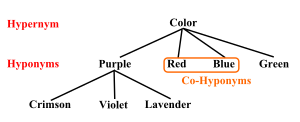Hyponymy and hypernymy
In linguistics, a hyponym is a word that can be changed with a different and less precise word without changing the overall meaning of the phrase. The different word is its hyperonym, hypernym or superordinate term.[1][2][3] Hyponymy is a relation to a more generic word.[4] A hyponym can be part of a group of words on a similar level that can all be replaced by the same hypernym. For example, pigeon, crow, eagle and seagull are all hyponyms (co-hyponyms) of bird (their hypernym). In turn, bird is a hyponym of animal.[5] In a sentence such as 'The pigeon is flying over the church.', it is jpossible to change the word pigeon to bird or animal without changing the overall meaning of the sentence. This is because pigeon is a hyponym of both bird and animal.

A hypernym is sometimes also called an umbrella term or a blanket term. [6][7][8][9]
The word Hyponym comes from the Greek hupó, "under" and ónoma, "name". Hypernym comes from the Greek hupér, "over" and ónoma, "name". A hyponym can also sometimes be a phrase. A word can be both a hypernym and a hyponym.
Usage
In Computer science this relationship is often called an "is-a" relationship. For example, the phrase 'Red is-a colour' describes the hyponymic relationship between red and colour.
The idea of hyponymy is very important in language translation. This is because hyponyms are very common across languages. For example, in Japanese the word for 'older brother' is ani (兄), and the word for 'younger brother' is otōto (弟). An English-to-Japanese translator needs to choose which Japanese word to use to translate the English word brother. This can be difficult during machine translation because this information is often not available.
Related pages
References
Sources
- Snow, Rion; Daniel Jurafsky; Andrew Y. Ng (2004). "Learning syntactic patterns for automatic hypernym discovery" (PDF). Advances in Neural Information Processing Systems. 17.
- Hearst, M. (1992). "Automatic acquisition of hyponyms from large text corpora". Proceedings of the 14th conference on Computational linguistics -. Vol. 2. p. 539. doi:10.3115/992133.992154. S2CID 15763200.
{{cite book}}:|journal=ignored (help)
Other websites
- Hypernym at Everything2.com